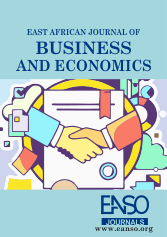Clarifying Roles, Enhancing Results: Job Descriptions and Employee Performance
الملخص
This study examines the influence of job descriptions on employee performance within organisational contexts, with a particular focus on how role clarity, structural design, and motivational elements contribute to individual and institutional outcomes. In an era where organisations continuously strive to enhance productivity, employee engagement, and strategic alignment, the role of clearly articulated job descriptions has become increasingly significant. Using a qualitative and descriptive research design, the study employs a systematic review of literature published between 2002 and 2022. The main objective is to synthesise theoretical perspectives and empirical findings to explore how well-structured and motivating job descriptions shape employee behaviour and drive organisational performance. The review reveals that comprehensive and clearly defined job descriptions reduce role ambiguity, improve task execution, and align employee efforts with organisational goals. Moreover, job descriptions that incorporate motivational components such as meaningful role framing, growth opportunities, performance-based rewards, and clear expectations are positively linked to higher levels of employee satisfaction, engagement, and intrinsic motivation. The evidence also highlights the role of job descriptions in strengthening accountability, supporting performance appraisal, and serving as a foundational tool across key HR functions, including recruitment, training, and career development. The study concludes that job descriptions should not be treated as static administrative tools but as dynamic, strategic instruments integral to effective human resource management. It recommends that organisations regularly review and update job descriptions to reflect evolving job demands and institutional priorities. By embedding clarity, structure, and motivational value into job descriptions, organisations can foster a high-performance culture that enhances employee commitment, innovation, and long-term organisational success.
التنزيلات
المراجع
Armstrong, M., & Taylor, S. (2014). Human Resource Management Practice 13th Edition, www.koganpage.com
Karlina, I., & Heriyanto. (2022). Effect of job description and employee performance of PDAM Tirta Musi distribution Palembang. Budapest International Research and Critics Institute Journal (BIRCI-Journal), 5(3), 19781–19790. https://doi.org/10.33258/birci.v5i3.6316
Levine, E. L., Sistrunk, F., McNutt, K. A., & Gael, S. (1988). Exemplary practices in job analysis: The U.S. Army Research Institute’s job analysis program. In S. Gael (Ed.), The job analysis handbook for business, industry, and government (Vol. 1, pp. 171–189). Wiley.
Orji, M. G., & Enyiamaka, E. P. (2022). Impact of incentives on employees’ performance in selected deposit money banks of the South-Eastern region, Nigeria. International Journal of Research in Marketing Management and Sales, 4(1), 39–45.
Raju, K. K., & Banerjee, S. (2017). A study on job description and its effect on employee performance: Case of some selected manufacturing organizations in the city of Pune, India. International Journal of Latest Technology in Engineering, Management & Applied Science, 6(6), 113–121.
Ramhit, K. S. (2019). The impact of job description and career prospects on job satisfaction: A quantitative study in Mauritius. SA Journal of Human Resource Management, 17(1), a1166. https://doi.org/10.4102/sajhrm.v17i0.1166
Rao, P. S., & Krishna, V. S. (2002). Human resource management: Text and cases. Excel Books.
Rawas, S. A. S. M., & Jantan, M. D. (2022). The effect of job description on employee performance in the Omani public sector: Mediating role of organizational justice. Technium Business and Management, 2, 8–16. https://techniumscience.com/index.php/businessandmanagement/article/view/60 40
Rinny, P., Purba, C. B., & Handiman, U. T. (2020). The influence of compensation, job promotion, and job satisfaction on employee performance. International Journal of Business Marketing and Management (IJBMM), 5(2), 39–48.
Robbins, S. P., & Coulter, M. (2002). Management (7th ed.). Prentice Hall.
Royer, J. (2009). Designing and updating job descriptions. University of Illinois at Chicago Human Resources. Retrieved from https://hr.uic.edu
Salim Mubarak Al Rawas, S. A., & Jantan, M. D. (2022). The effect of job description on employee performance of the Omani public sector: Mediating role of organizational justice. Technium Business and Management, 2(1), 8–16.
Sinambela, L. P., Asmara, M., & Sudarwati, R. (2011). Kinerja pegawai: Teori pengukuran dan implikasi. Graha Ilmu.
Snyder. H (2019). Literature review as a research methodology: An overview and guidelines, Norwegian School of Business, Oslo, Norway.
Thangavelu, A., & Sudhahar, C. (2017). A study on job descriptions and their impact on employee performance in the textile industry. International Journal of Research in Management & Business Studies (IJRMBS), 4(1), 12–15.
UIC (University of Illinois at Chicago). (2009). Guidelines for job description development. UIC Human Resources. https://hr.uic.edu
Utin, N. H., & Yosepha, S. Y. (2019). The model of employee performance. International Review of Management and Marketing, 9(6), 123–132. http://www.econjournals.com/index.php/irmm/article/view/9255
Vikas, G., & Hitesh, K. (2016). Job description and employee performance: A study of the Indian IT industry. International Journal of Management and Applied Science, 2(1), 5–10.
Wiwin. (2012). Pengaruh kejelasan uraian tugas terhadap kinerja karyawan. In Karlina & Heriyanto (2022), the Effect of job description and employee performance of PDAM Tirta Musi distribution Palembang. BIRCI-Journal, 5(3), 19781–19790.
الحقوق الفكرية (c) 2025 Francis Twinamasiko

هذا العمل مرخص حسب الرخصة Creative Commons Attribution 4.0 International License.




























